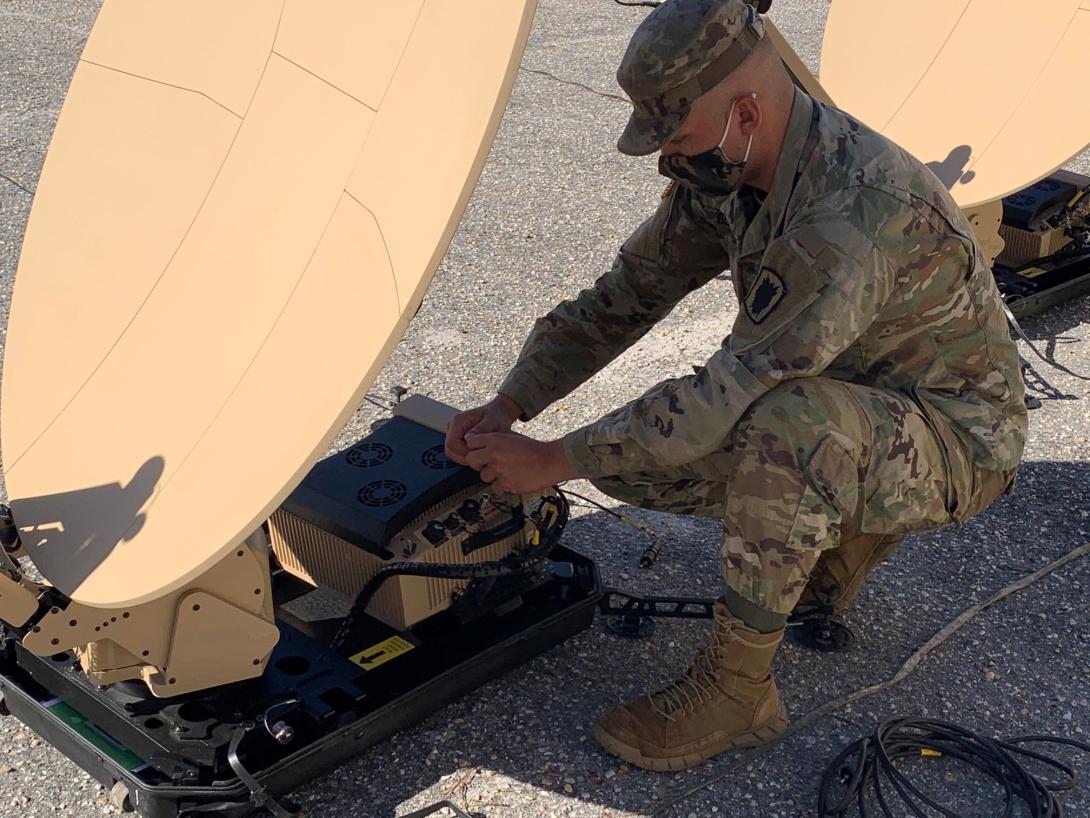Enhanced Battalion Signals Army's Future
The new, lighter-weight equipment being delivered to the Army’s prototypal enhanced signal battalion allows the unit to move faster and communicate better, which ultimately should enable warfighters to shoot more effectively.
The 50th Expeditionary Signal Battalion-Enhanced (ESB-E) is an immediate response force that provides worldwide contingency, force projection and forced-entry signal support to the XVIII Airborne Corps for power-projection operations during war and operations other than war.
In January, the service’s Program Executive Office for Command, Control and Communications–Tactical completed fielding the Scalable Network Node. The Army is using a process known as pure fleet fielding, which ensures a unit has the same equipment throughout its formation. With this smaller, lighter tactical network system, ESB-Es can more rapidly deploy and maneuver across the battlefield while providing resilient network connectivity to supported units. The new nodes can be set up in minutes and can provide immediate network connectivity using its organic generators until increased power is delivered, according to an Army article. The reduction in size and complexity permits ESB-Es to increase network support to other units with more nodes and less manpower while reducing transportation requirements by more than 60 percent.
“The Scalable Network Node, SNN, is a series or a family of scalable, very small aperture terminals along with baseband. It provides the 50th and other ESBs that will convert to ESB-Es that early-entry signal support in all phases of combat operations,” says Lt. Col. Stuart McMillan, USA, product manager for Mission Network, Program Executive Office–Command, Control and Communications–Tactical. “It provides a tailorable capability that can be set up in a matter of minutes, and of course, provides data and voice services, such as NIPRNET and SIPRNET.” NIPRNET and SIPRNET are acronyms referring to the Non-Secure Internet Protocol Router Network and the Secret Internet Protocol Router Network.
Also included in the ESB-E Capability Set 21 equipment package is the expeditionary high-throughput Terrestrial Transmission Line of Sight Radio, which gives warfighters signal path diversity in congested and contested environments; secure wireless for rapid command post set up and tear down; and network enclaves that connect to commercial and coalition networks. The agile network tool suite is tailorable and scalable with medium and large satellite communication systems to offer support to different sized units, from teams up to corps elements, in a wide variety of mission sets, the Army article explains.
Last month the Army expected to complete fielding of the inflatable Transportable Tactical Command Communications terminals and a couple of additional systems. The initial entry satellite system makes available voice, video and data communications without the need of static infrastructure. The fielding also will upgrade the unit’s existing systems to enable Ka, Ku and X band versus the original Ka capability used in the pilot.
Additionally, by June 2021, the Army expects to complete fielding Commercial Coalition Equipment, which yields coalition or commercial network connectivity for mission command, voice, video, and data communications and situational awareness between Army, joint and coalition forces.
Equipment still in test or final development includes a next-generation Tropospheric Scatter Transmission system that will afford expeditionary beyond-line-of-sight capability to extend network range and increase throughput; and it permits an improved version of the Phoenix ground satellite terminal that gives high-bandwidth network communications for large division and corps headquarters. The Phoenix systems are used for high-throughput missions, such as unmanned aerial system feeds and video teleconferencing.
The Army will field several ESB-Es per fiscal year until all 23 ESBs have been upgraded to the new baseline capability, currently targeted for completion in fiscal year 2028. The program’s agile acquisition and fielding approach aligns with the Army’s two-year incremental capability set fielding process, which will allow the service to enhance the ESB-E baseline capability. The service also began fielding to the 57th ESB in November 2020 and will begin fielding to the 304th ESB in the third quarter of the 2021 fiscal year. Other tactical network capabilities in the full ESB-E capability set are in various stages of development, Army officials say.
Lt. Col. Mallory Wampler, USA, who commands the 50th ESB-E, says the unit already is more agile and effective with the equipment received so far, primarily because the technology is lighter and easier to deploy. “When you’re dealing with such a small physical package, even with some of the components requiring a two-person lift, the maneuverability and logistics associated with the communications support is light years compared to what it was previously,” she says.
The smaller, lighter equipment can be carried as excess baggage on commercial flights, allowing more rapid deployment. “It provides the 50th the opportunity to load up very quickly on a commercial aircraft, whereas before they would have to rely on a strategic military lift to get their equipment out there,” Col. McMillan explains.
Officials cannot quantify how much lighter the new equipment is than the old, but Col. Wampler describes the difference as “profound.”
The reduction in personnel needed to deploy and operate the equipment also makes a difference, the commander notes. “Now, the core of the ESB-E is the Scalable Network Node, and that takes a four-person team. A four-soldier team is all that any supported unit would have to consider logistically as far as classes of supply and what have you, versus what it was before. Those team compositions were much larger than four personnel.”
And those signal support teams can be led by low-ranking soldiers when necessary. “Even though I would love to have team chiefs be sergeant E-5s and above, I have several—I’m not kidding—who are privates first class. We just completed our first Combat Training Center rotation with the new kit in support of 3rd Brigade Combat Team, 82nd Airborne Division, and I had a private first class supporting the brigade tactical operations center,” she reports.
Having privates act as team leaders is great for developing leadership skills, but the service is wrestling with the full ramifications. “Leader development has always been a large component of what we do in the military, but the concept of having a four-soldier team at the essence of everything we do drives the importance of those team chiefs and the development of them and their ability to integrate with a supported unit,” Col. Wampler says. “Obviously, we’re having to wrap our brains around what that means in the training pipeline of getting teams validated, but it’s an awesome opportunity too, for junior soldiers to have that engagement.”
While the coronavirus pandemic wreaked havoc during the unit’s recent Combat Training Center rotation, the new equipment worked well. When the supported division lost network connectivity on two of its larger-sized Transportable Tactical Command Communications-Heavy systems, the smaller Scalable Network Nodes, which had been in place as a division backup capability, were switched to become the primary form of communication, which Col. Wampler describes as “a huge win.”
Another lesson learned is the need to ensure personnel supporting ESB-E network management at the Army’s Regional Hub Nodes receive additional training on new systems to properly advise on troubleshooting practices, including the Scalable Network Node. “It’s just a learning curve that needs to be taught and that will come absolutely with time, the normal friction that comes with something this new. It’s just shared learning, but everybody always figures out how to make it happen and make comms work,” the commander says.
The service already has taken steps to address the issue, she adds. “I know we’ve identified that at echelon, that we could have probably benefited by pulling the regional hub node into our new equipment training that we did here. We have synchronized with the Fort Bragg Regional Hub Node, and we just recently deployed a team with the Landstuhl Regional Hub Node because I’m going to have a company over in Europe this summer executing Defender Europe 21,” she reveals. “I know that between those two regional hub nodes, the cross training has absolutely occurred and will pay dividends.”
Col. McMillan points out that the Program Executive Office for Command, Control and Communications continues to support the 50th ESB-E, in part by making improvements wherever necessary based largely on soldier feedback. “We’re working hand-in-hand with the unit. It’s not a drive-by fielding where we drop the kit off and train up soldiers and say, ‘Good luck.’”
The Army was expected to complete fielding of the Scalable Network Node to the 57th Signal Battalion at Fort Hood in March and then move on to the next unit. “We are learning lessons from each of our fieldings and improving the process from a new equipment training and new equipment fielding process,” Col. McMillan adds. “As we iterate the next ESBs, it’s going to become muscle memory and will make it that much better when we field new field units in the future.”
Col. Wampler also shares lessons learned with her fellow commanders in the other ESBs converting to ESB-Es, one of whom she describes as a “battle buddy.” The commander says feedback from soldiers so far has been positive and not just from signal soldiers. “It’s not just our soldiers that like the equipment more. It’s our customers. The missions haven’t stopped. The demand signal is still out there. The warfighters really like the direction that we’re going,” she concludes.






Comment
Will the ESBs be leveraging
Will the ESBs be leveraging the new IVAS/HoloLens 2 systems? Will they be implemening a Cloud architecture to leverage the new technology?
Comments